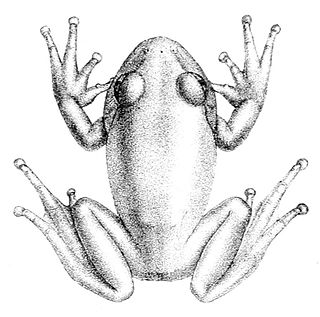
Cardioglossa is a genus of frogs in the family Arthroleptidae known as long-fingered frogs. They are native to western and central Africa, with the greatest species richness in Cameroon. They are found near streams in lowland and mountain forests, but also occur in other highland habitats near streams at up to 2,700 m (8,900 ft) in altitude. These are small frogs with a snout-to-vent length of 2 to 4 cm (0.8–1.6 in). Some of the more localized species are threatened.

Ptychadena is a genus of frogs in the grassland frog family, Ptychadenidae. They are distributed in Sub-Saharan Africa, as well as nilotic Egypt. The common names of this genus are ridged frogs and grass frogs. This type of family have many different characteristics such as the species, Ptychadena neumanni who have long hindlimbs and a large ear drum compared to the Ptychadena erlangeri, for example. They also have a unique bone structure which is a fusion between the presacral vertebrae and sacrum.

Franz Josef Maria Werner was an Austrian zoologist and explorer. Specializing as a herpetologist and entomologist, Werner described numerous species and other taxa of frogs, snakes, insects, and other organisms.

Afrixalus, commonly known as the banana frogs, spiny reed frogs, cat's eye reed frogs, or leaf-folding frogs, is a genus of frog in the family Hyperoliidae. They occur in the Subsaharan Africa. They lay their eggs in vegetation above water, often folding leaves around the eggs for protection—hence the common name "leaf-folding frogs".

Hyperolius is a large genus of frogs in the family Hyperoliidae from Sub-Saharan Africa.

Leptopelis aubryi, also known as the Aubry's tree frog and Gaboon forest treefrog, is a species of frog in the family Arthroleptidae. It is found in southeastern Nigeria, Cameroon, Central African Republic, Equatorial Guinea, Gabon, Republic of the Congo, western and northern Democratic Republic of the Congo, and Angola.
Leptopelis bequaerti is a species of frog in the family Arthroleptidae. It is endemic to Liberia and only known from its type locality, Gbarnga, and from Mount Coffee. Common name Gbanga forest treefrog has been coined for it. It is a poorly known species with uncertain taxonomic validity.

The Cameroon forest tree frog is a species of frog in the family Arthroleptidae. It is found in southern Nigeria, Cameroon, Equatorial Guinea, and Gabon. It is expected to occur in southwestern Central African Republic and in the Republic of the Congo, but no records have been confirmed from those countries.

Leptopelis broadleyi is a species of frog in the family Arthroleptidae of uncertain status. The Amphibian Species of the World, the IUCN SSC Amphibian Specialist Group, and the African Amphibians do not recognize it, but instead consider it synonym with Leptopelis argenteus. However, the AmphibiaWeb recognizes it as a valid species.

Leptopelis flavomaculatus is a species of frog in the family Arthroleptidae. It is found in the lowlands eastern and southern Africa, from Mozambique north of the Save River and Zimbabwe to Malawi, eastern Tanzania, and coastal Kenya. Its common names are yellow-spotted tree frog, brown-backed tree frog, brown forest treefrog, and Johnston's treefrog.

Leptopelis macrotis, sometimes called the big-eyed forest tree frog, is a species of frog in the family Arthroleptidae. It is found in the rainforests of Sierra Leone, southern Guinea, Liberia, Ivory Coast, and southern Ghana. Notice that similar common name "big-eyed tree frog" is sometimes used for Leptopelis vermiculatus from Tanzania and for Litoria exophthalmia from New Guinea.

Leptopelis millsoni is a species of frog in the family Arthroleptidae. It is found in southeastern Nigeria, Cameroon, the Central African Republic, Equatorial Guinea, Gabon, the Republic of the Congo, the eastern Democratic Republic of the Congo, and northwestern Angola. Common names Niger forest treefrog and Millson's Tree Frog have been coined for it. There is a need of taxonomic revision of this taxon.

The Tai forest tree frog is a species of frog in the family Arthroleptidae. It is found in Liberia, southern Ivory Coast, and Ghana. Records from Nigeria are controversial and may refer to other species, possibly Leptopelis boulengeri.
Leptopelis oryi, also known as the Garamba forest treefrog and Ory's tree frog, is a species of frog in the family Arthroleptidae. It is found in the northeastern Democratic Republic of the Congo, northwestern Uganda, and adjacent South Sudan. It is morphologically similar to Leptopelis nordequatorialis from Cameroon, and has also been considered its synonym, but is currently treated as a distinct species. The specific name oryi honours Albert Ory, warden in the Garamba National Park, the type locality of this species.

The palm forest tree frog is a species of frog in the family Arthroleptidae which is endemic to Príncipe island in São Tomé and Príncipe. Red tree frog Leptopelis rufus from the African mainland was for a long time included in this species, but is now considered a distinct species.

The red tree frog is a species of frog in the family Arthroleptidae. It is found in southeasternmost Nigeria, western Cameroon, Equatorial Guinea, western Gabon, the lower Republic of the Congo, the lower Democratic Republic of the Congo, and northwestern Angola. It has been confused with several other species, in particular with the palm forest tree frog Leptopelis palmatus.

Leptopelis viridis is a species of frog in the family Arthroleptidae. It is widely distributed in the West and Central African savanna zone between Senegal and the Gambia to the northeastern Democratic Republic of Congo.

Phrynobatrachus is a genus of Sub-Saharan frogs that form the monogeneric family Phrynobatrachidae. Their common name is puddle frogs, dwarf puddle frogs, African puddle frogs, or African river frogs. The common name, puddle frog, refers to the fact that many species breed in temporary waterbodies such as puddles.


















